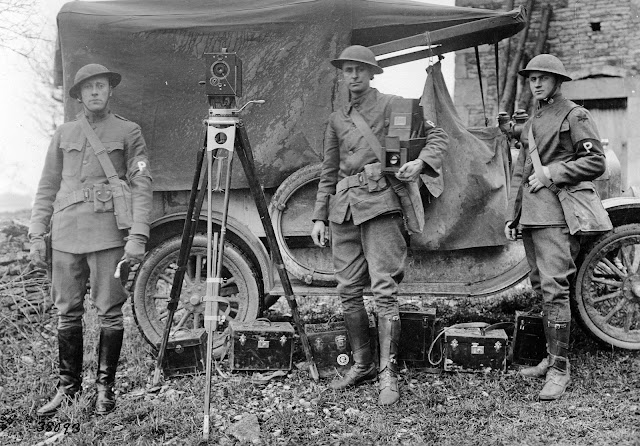On May 28, 1918, Signal Corps cameraman Edward R. Trabold went over the top with the 1st Division of the American Expeditionary Force, taking combat pictures of American soldiers in action at Cantigny. The battle of Cantigny is best remembered now as the first major American offensive of World War I.
 |
Photographic unit of the 6th Division, A.E.F, 1919. Trabold with his Graflex camera is in the middle. Photograph from the National Archives, courtesy Harry B. Kidd
|
Trabold's personal story
Counterattacking with a Camera on his experiences at Cantigny was published in 1919. He was by all accounts the first official U.S. Signal Corps photographer to take combat pictures of American soldiers during a major offensive in the First World War. Unfortunately, Trabold had to give his pictures to the Signal Corps. When he published his personal account he could not show any of the photographs that he had made during the attack, but reports indicate these pictures were of tanks and the men of the 1st Infantry Division storming Cantigny. The prints probably are still at the National Archives in Washington, D.C, and definitely merit additional research.
The Cameraman: Edward R. Trabold
During this assignment Trabold was accompanied by his commanding officer, Captain Paul Miller, who had been sent to Europe by the Signal Corps in May 1917 to report on the possibilities of setting up a photographic laboratory in France. Trabold himself is another interesting figure. Born in North Addams, Massachussets, in 1883, he started his first studio in 1906 with an old 4 x 5 Graflex camera as his principal piece of photography. Joined in the enterprise by his brother Peter, who had been teaching art, he specialized in producing photograph buttons, a novelty at the time, bearing pictures of loved ones and public figures. Trabold later became a newspaper photographer, working in Montana, and enlisted in the Signal Corps in 1917. After the war, Trabold became a newsreel cameraman for
Pathé News, working in Omaha, Nebraska, where he had set up a new photographic studio. In the 1950s, Trabold was also active producing films for television.
 |
Trabold in Signal Corps photographic laboratory near Paris, April 1918. Picture from the collection of the National Archives in Washington, D.C.
|
First Combat Photographer
Shortly before his death in December 1955, Trabold corresponded with the Signal Corps on his photographic work during World War I. He was quite anxious to know if he was in fact the first cameraman to have taken combat pictures of the American Expeditionary Force at Cantigny. The Signal Corps after careful consideration replied that he probably was. Trabold appears to have taken both still and moving pictures when he was in France. The attack on Cantigny he only covered with a still camera. In his account Trabold mentioned no movie cameras were allowed because these would draw enemy fire. It still was a very dangerous job. Trabold was wounded by machine-gun fire and escaped from death by shells that were falling all around. At the end of the day he arrived at a medical station where his wounds were treated.
"The Big Red One"
 |
Colonel Robert R. McCormick in World War I
|
On an interesting side note, Colonel Robert R. McCormick , editor of the
Chicago Tribune, was an officer with the 1st "The Big Red One" Division during the attack at Cantigny. McCormick was instrumental in innovating his newspaper, and he worked closely with cinematographers Edwin Weigle and Donald Thompson on a number of contemporary World War I films that were released by the
Chicago Tribune. You will find more on his work in our book
American Cinematographers in the Great War.
Here is an audio link with a speech by McCormick, commemorating the historical significance of the American attack at Cantigny.
After his harrowing experiences at Cantigny, Edward Trabold was promoted to Sergeant 1st Class and transferred to the 6th Division, A.E.F. He was in the field as an official photographer from March 1918 until May 1919 when he was discharged from the Signal Corps.
Here is a download link to Trabold's story Counterattacking with a Camera which was published in the Photographic Journal of America in September 1919.














